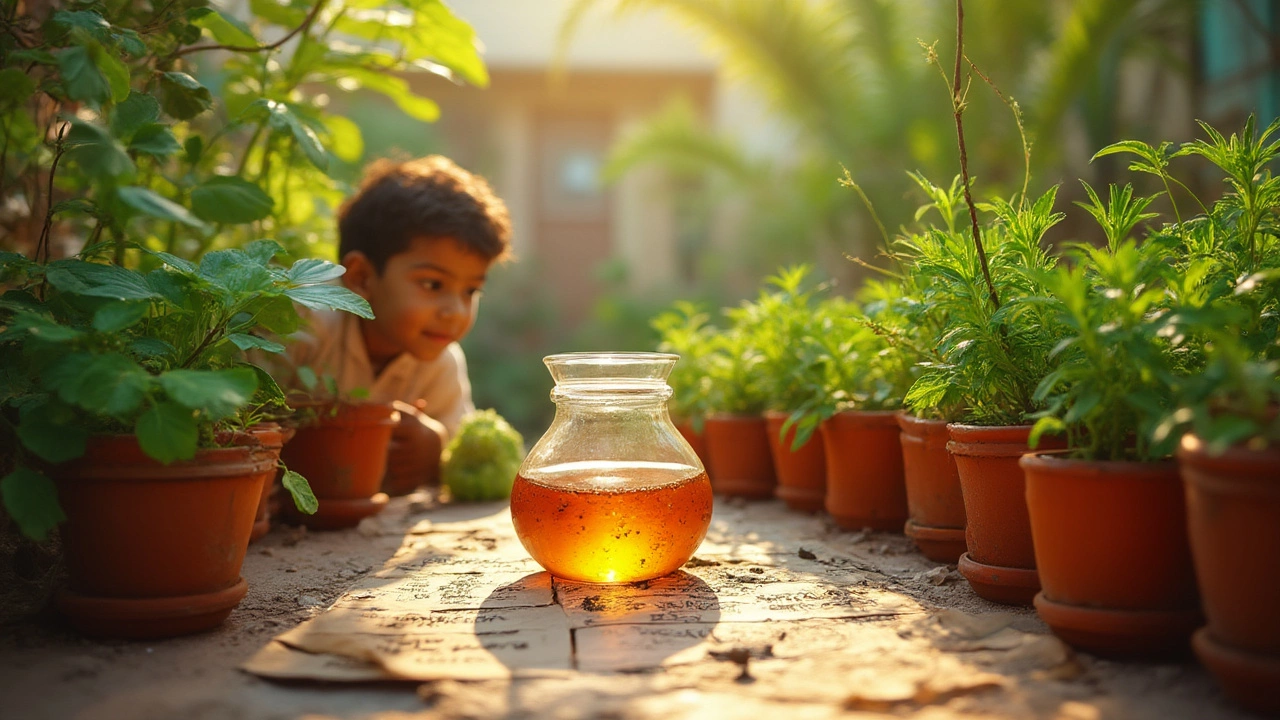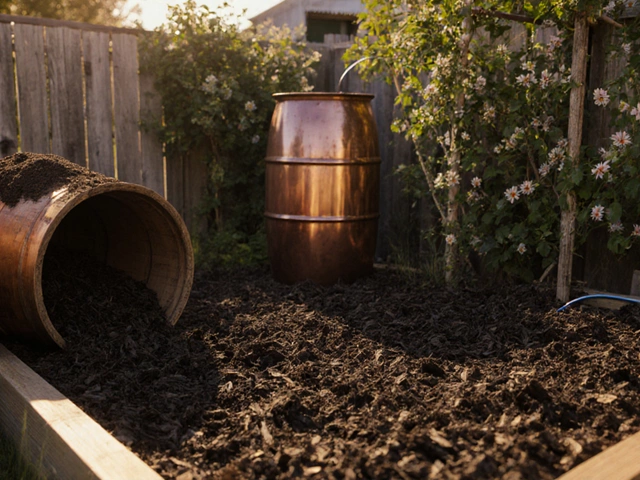If you've ever struggled to keep bugs off your prized basil, you've probably heard someone whisper about apple cider vinegar (ACV). Some people swear it’s a miracle worker, an innocuous pantry hero ready to bust aphids and gnats off your plants. But does it really stand up to the old-fashioned bugspray? Or is it just another folk tale carried along by viral life-hacks? Let's roll up our sleeves and get honest about what happens when you bring ACV into the garden.
What Is Apple Cider Vinegar and What Does It Do to Bugs?
Apple cider vinegar, or ACV for short, starts with fermented apple juice. Yeast gobbles up the sugars and churns out alcohol, and then good bacteria turn that alcohol into acetic acid. That acid is what puts the "vinegar" in apple cider vinegar—and what gives it that signature sour punch. Most bottles you buy at the grocery store hover around 5% acidity, although some brands make stronger versions for cleaning.
So, why do so many gardeners reach for a bottle of ACV when bugs show up? It comes down to that acid, which can dry out or outright kill soft-bodied insects, especially tiny gnats and aphids. Some folks also say the sharp scent confuses pests and keeps them at bay. Still, let’s be real: not every critter hates the smell of vinegar (fruit flies, for example, find it pretty inviting).
But before you tip your salad dressing all over your spinach bed, remember: not all acids are gentle. Just as ACV can shrivel bugs, it can also damage your plants if used carelessly—a splash of undiluted vinegar on leafy greens will leave brown, wilted spots by tomorrow. And let’s not forget, ACV won’t magically keep all pests away. Hard-shelled beetles, caterpillars, and grasshoppers often couldn’t care less.
What does the science say? Studies published in small-scale garden journals and bulletins show vinegar solutions may disrupt the soft exoskeleton or breathing passages of certain soft-bodied pests like aphids, mealybugs, and fungus gnats, but the effect depends on strength, frequency, and pest type. Root nematodes, hornworms, or leafhoppers? Not so much. Most extension offices from major universities, like the University of California Cooperative Extension, stress that vinegar sprays should be used cautiously and are not a catch-all bug killer.
Here’s a quick rundown of which bugs ACV sometimes works on:
- Aphids (partly effective)
- Fungus gnats (as a lure, not as a spray)
- Fruit flies (excellent homemade trap ingredient)
- Mealybugs (potentially, if directly hit)
And here’s who shrugs it off:
- Caterpillars
- Beetles
- Grasshoppers
- Ants (sometimes, but usually temporary)
Bottom line: You’ll want to know your enemy before you reach for ACV in your pest-fighting battle plan.
How to Use Apple Cider Vinegar Safely as an Insecticide
Let me spill the truth: pouring vinegar all over your plants is a surefire way to burn leaves, kill flowers, and even stress the roots. So, if you’re itching to try ACV, you need a recipe—dilution isn’t just a good idea, it’s non-negotiable. Most gardeners swear by mixing 1 part apple cider vinegar with 3 to 6 parts water. Don’t use anything undiluted, and avoid pouring it directly onto your soil or roots.
Here’s a step-by-step strategy for mixing and applying ACV safely:
- Mix It Right: Start with 1 tablespoon of ACV in 2 cups of water for a mild spray (strong enough for annoying gnats, gentle enough for leaves). Are your pests tough? You might try 1 tablespoon ACV to 1 cup water, but test it on one leaf first.
- Load a Spray Bottle: Transfer your mixture to a clean spray bottle. Give it a good shake.
- Spot Test: Spray a small patch of the plant. Wait 24-48 hours. If the leaves look unfazed, you can continue. If they turn brown or wilt, dilute further—don’t risk ruining the whole plant.
- Spray Judiciously: Target only affected areas—especially the underside of leaves where pests like to hide. Try to keep spray off flowers, fruits, and nearby healthy plants.
- Repeat as Needed: You might have to spray every 2-3 days to tackle stubborn bugs, but always spot test if you change the mix ratio.
- Trap Instead: For gnats or fruit flies, skip the spray and make a simple trap. Pour ACV and a drop of liquid dish soap in a shallow bowl. The flies are drawn by the smell, land for a taste, and the soap breaks the surface tension so they drown. Works like magic in a day or two. Check and empty daily.
Don’t use ACV sprays if your plants are stressed, wilted, or recently fertilized. Vinegar is just too harsh on weakened greenery. And if rain is coming, hold off—vinegar loses effectiveness when washed away.
Here’s an easy table that breaks down safe ACV dilution ratios for different uses:
| Use | ACV | Water | Method |
|---|---|---|---|
| Mild Spray (aphids, mealybugs) | 1 tbsp | 2 cups | Spray on leaves, spot test first |
| Stronger Spray (stubborn gnats) | 1 tbsp | 1 cup | Spray, watch for leaf burn |
| Fruit Fly Trap | 1/2 cup | None | Pour in bowl with 2-3 drops soap |
| Fungus Gnat Trap | 1/2 cup | None | Bowl near soil; cover with plastic, poke holes |
ACV is totally safe for humans and pets when diluted, but don’t let pets drink the traps—cats, in particular, seem overly curious.

Comparing Apple Cider Vinegar to Other Natural Insecticides
ACV has its place in the natural gardener’s toolkit, but it’s not the only non-toxic weapon you can wield. Sometimes, you’re better off reaching for something else—especially if you’re fighting a wider variety of bugs or want to protect delicate plants.
Neem oil, for instance, has gone from obscure Ayurvedic ingredient to the poster child for organic pest control. Unlike ACV, neem oil contains azadirachtin—a compound that messes with insect hormones and works on everything from leaf miners to spider mites. It’s also safer long-term for both plants and beneficial bees, since you can spray the soil and leaves without scorching. That said, neem can smell a bit funky, and some people complain about staining. Still, it often knocks out pests resistant to vinegar, making it a staple in the organic aisle.
Another option is insecticidal soap. These are special fatty soaps designed to disrupt bug membranes without hurting plants or pollinators. They’re crazy easy to use: just mix and spray, even in hot weather. They’re especially reliable for aphid colonies, thrips, and mealybugs. The catch? You’ll need good coverage and regular applications, especially after rain.
And for a truly old-school trick, diatomaceous earth is a powder made from fossilized algae. Spread this dust on leaves or soil, and it acts like microscopic razor blades, cutting up insect bodies and dehydrating them. Works great for ants, roaches, and beetle larvae—just keep it dry, since water makes it ineffective.
Let’s toss these contenders into a quick comparison table:
| Control Method | Main Target Pests | Safe for Plants? | Ease of Use |
|---|---|---|---|
| Apple Cider Vinegar | Aphids, fungus gnats, fruit flies | Only when diluted | Very easy (spray or trap) |
| Neem Oil | Wide spectrum: mites, aphids, whiteflies | Yes (most plants) | Moderate (may require mixing) |
| Insecticidal Soap | Aphids, spider mites, thrips, mealybugs | Mostly yes | Very easy (pre-mixed) |
| Diatomaceous Earth | Ants, beetles, grubs | Yes | Sprinkle/dust needed |
So, while ACV is a quick fix for the occasional gnat or aphid, it can’t replace other proven methods. Think of it as your "grab-and-go" solution—worth trying, but not your only line of defense.
Real-Life Results, Pro Tips, and What to Avoid
Not every garden hack passes the reality check. While apple cider vinegar can do a reasonable job of thinning out soft-bodied populations, it’s not a magic wand. Gardeners who’ve tried it often report wildly different results depending on weather, bug population, and even the plant species. Some see instant improvement in fungus gnat populations inside potted herbs; others notice hardly any change after dousing aphid clusters on kale.
Here are some practical tips from hands-in-the-dirt gardeners who’ve tested ACV themselves:
- Don’t use ACV in the midday sun. The combo of acid and heat will fry leaves—drench your plants in the evening or early morning for the best results.
- Combine with sticky traps for gnats. Spray ACV for gnats and put yellow sticky cards around the base of indoor pots to finish the job.
- Never use on seedlings or new transplants. Their tissues are just too delicate, and you risk doing more harm than any possible good.
- Store-bought ACV is fine—don’t use “cleaning vinegar,” which is extra strong and dangerous for anything living.
Avoid these common pitfalls:
- Avoid spraying close to bees or open blossoms. While ACV isn’t highly toxic to pollinators, the acid and fumes can still drive them away or damage flowers.
- Never use it as a soil drench for root pests—vinegar kills roots quickly.
- Don’t mix with other strong solutions like bleach or ammonia—those are never safe for your plants or the local ecosystem.
What about results? The data is mixed, but the consensus is that ACV shines brightest in small, indoor environments and as part of a targeted attack, not as your main strategy for outdoor garden pest management. It’s especially useful for catching that one kitchen fruit fly that just won’t quit. For bigger pests or large-scale infestations? You're much better off with neem oil, insecticidal soap, or simply blasting leaves with a hose.
Bottom line: Apple cider vinegar is handy, cheap, and biodegradable. It won’t solve every bug problem (no matter what YouTube promises), but it can help when used with care and a dash of healthy skepticism. Next time you spot gnats circling your houseplants or aphids clustering in a corner of your lettuce patch, give ACV a shot—but keep your expectations, and that bottle of neem, close by.



